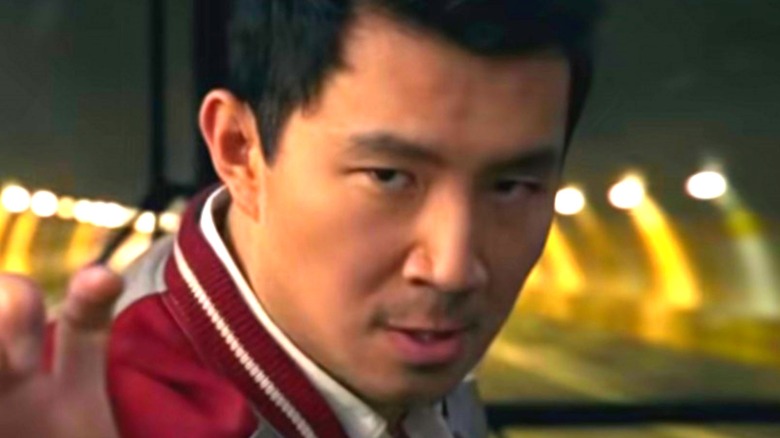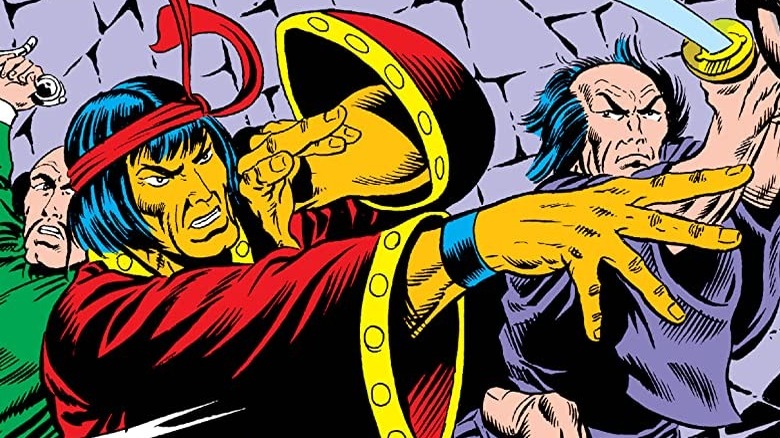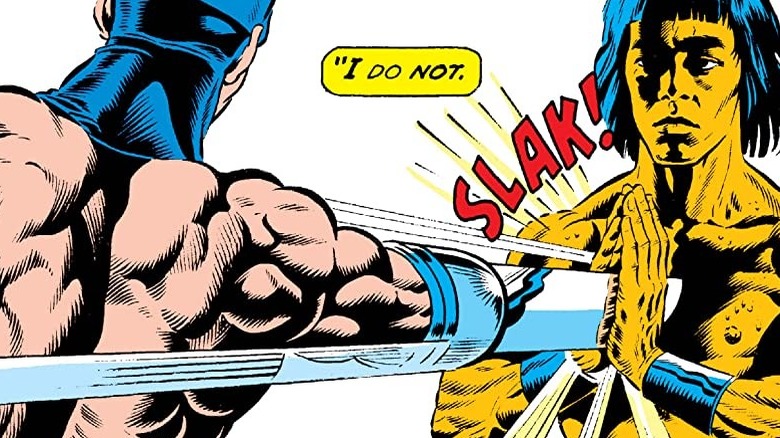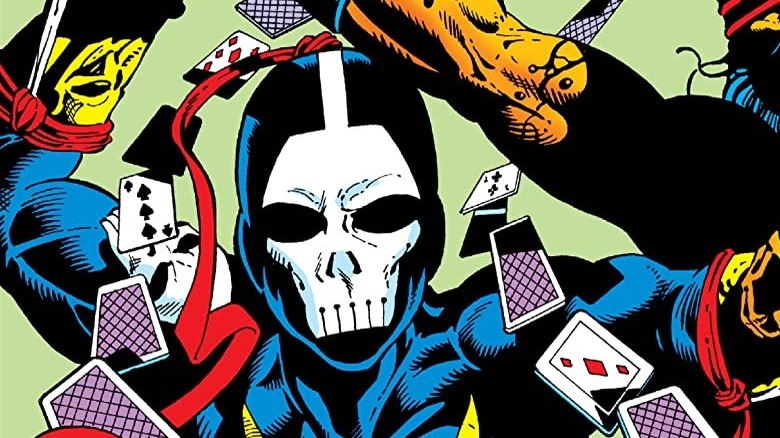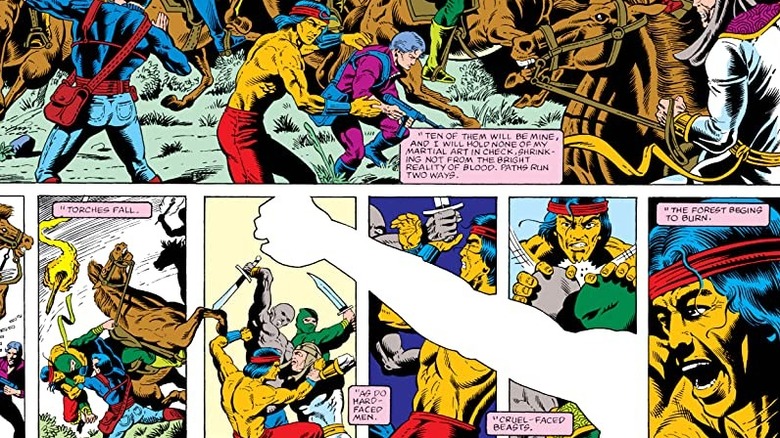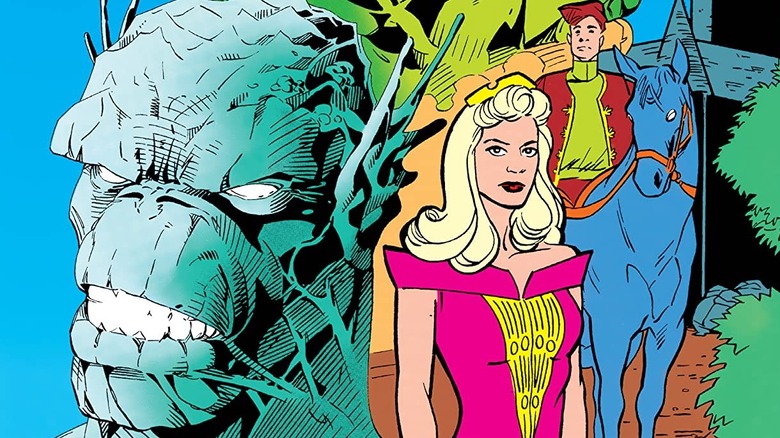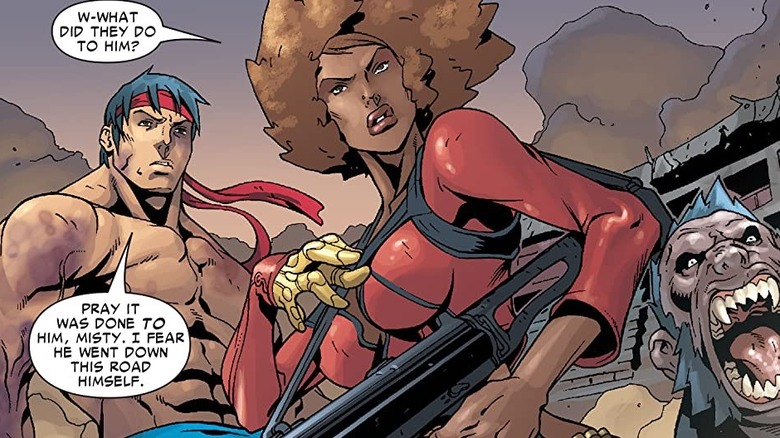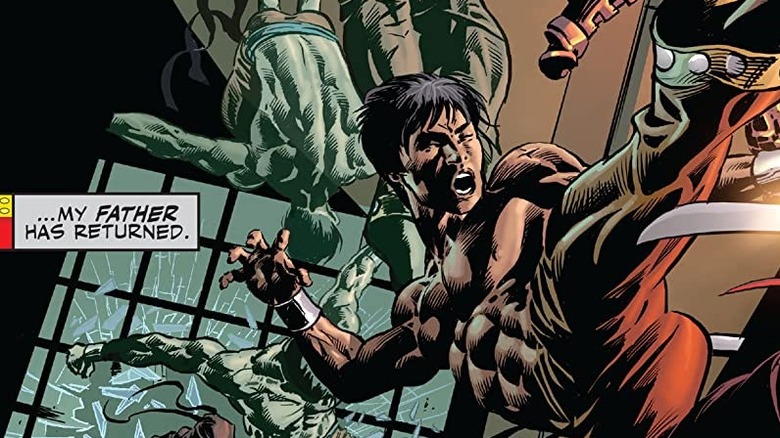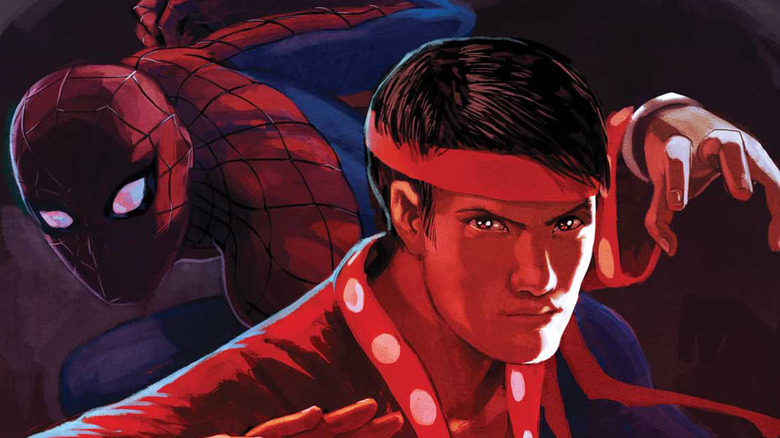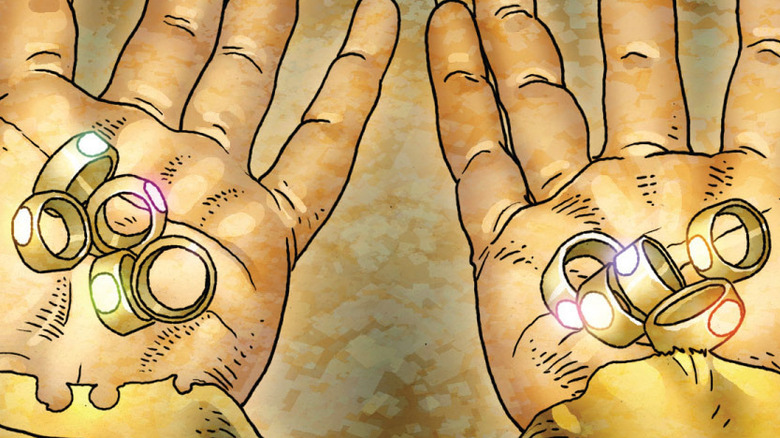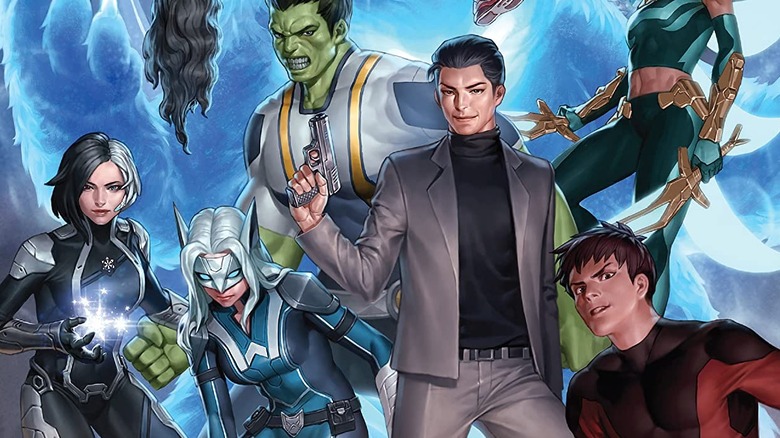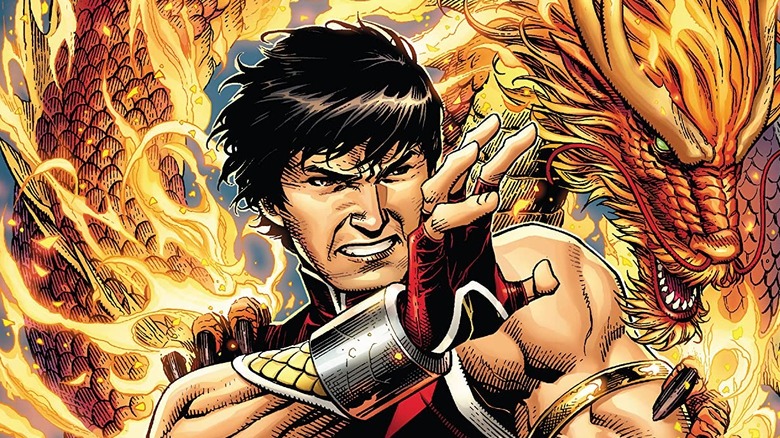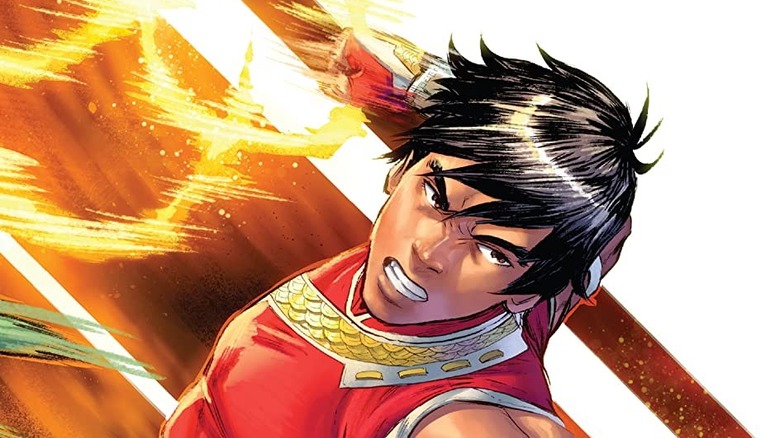Marvel Comics To Read Before You See Shang-Chi
"Who are you?" That's the question Katy (Awkwafina) aims at Shang-Chi (Simu Liu) in the trailer for "Shang-Chi and the Legend of the Ten Rings," one sure to be echoed by fans eager to meet the Marvel Cinematic Universe's latest hero. Created by writer Steve Englehart and artist Jim Starlin, Shang-Chi is one of the world's greatest martial artists. After discovering that his father is the ruler of a criminal empire, Shang-Chi dedicates his life and fighting skills to combating evil.
Since his first appearance in 1973, Shang-Chi has been a powerful recurring hero in the Marvel Universe, leading a solo series and teaming up with Spider-Man, the Avengers, and even the X-Men. But Shang-Chi's publishing history is more complicated than the average Marvel superhero. He was originally spun-off from a licensed property, the Sax Rohmer novels featuring the "Yellow Peril" villain Fu Manchu. Later stories would untangle their connection, but the "Master of Kung Fu" series starring Shang-Chi from 1974 to 1983 would not be reprinted until 2016. It can be difficult to find a jumping-on point for new readers, so here is a guide to essential Marvel comics spotlighting the hero (and villains!) of "Shang-Chi and the Legend of the Ten Rings."
(Content warning: some of these early comic book appearances, published almost 50 years ago, contain outdated and offensive language, as well as depictions of anti-Asian stereotypes such as Fu Manchu.)
Shang-Chi, Master of Kung Fu!
"The most fantastic, the most fascinating new hero of this or any other year!" So was the world introduced to Shang-Chi in 1973's "Marvel Special Edition" #15. The son of the criminal mastermind Fu Manchu, Shang-Chi is raised in seclusion and trained in the martial arts to become, in his father's words, a "living weapon." Unaware of his father's true nature, Shang-Chi assassinates an old enemy at his behest — only for Sir Denis Nayland Smith (Fu Manchu's nemesis from the Sax Rohmer novels) to reveal the terrible truth about his father's crimes.
Shang-Chi fights his way through his father's compound — battling an evil gorilla along the way — to confront Fu Manchu for the first, but not final, time. As drawn by Jim Starlin (creator of Thanos and Gamora), Shang-Chi is a dynamic hero but a tragic one, forever destined to be his father's mortal enemy. Shang-Chi quickly caught on with readers; "Marvel Special Edition" was renamed "Master of Kung Fu" with issue #17 and chronicled Shang-Chi's adventures for nearly a decade.
The Rampage of Razor-Fist
Sharp-eyed viewers of the "Shang-Chi" trailer will see Razor-Fist (Florian Munteanu) slashing his way through a San Francisco bus. While multiple villains in Marvel Comics have gone by the Razor-Fist moniker (including two robots made by Dr. Doom), the first Razor-Fist was William Young. An assassin under the employ of eccentric narcotics dealer Carlton Velcro, Razor-Fist first tussles with Shang-Chi in "Master of Kung-Fu" #29-31 (1975).
Accepting a mission from Nayland Smith, Shang-Chi infiltrates Velcro's fortress on the coast of France to stop the drug lord, only to encounter Razor-Fist. With both hands replaced by steel blades, Razor-Fist is a fearsome opponent for even the world's most skilled martial artist, and Shang-Chi needs to think fast –- and act faster -– if he wants to disarm him. Despite having one of the sillier (and most literal) names of any Marvel supervillain, Razor-Fist is an essential member of Shang-Chi's rogues gallery. And whatever you do, don't shake his hand!
Death-Dealer
Another classic comics villain will make his first on-screen appearance in the MCU: the masked warrior known as Death-Dealer. Debuting in "Master of Kung Fu" #115 (1982), Death-Dealer is MI-6 agent Li Ching-Lin, secretly loyal to Fu Manchu. The double agent trades one false face for another as Fu Manchu hands Li a skull-faced mask: "You must now become ... Death-Dealer!"
Shang-Chi's first confrontation with Li shakes his trust in his newfound father figure Nayland Smith, leaving him vulnerable to Death-Dealer's next attack. Armed with a grenade launcher, a three-bladed weapon, and a pack of playing cards (Gambit, eat your heart out), Death Dealer proves worthy of his name. Played by Andy Le in "Shang Chi and the Legend of the Ten Rings," Death-Dealer can be seen in the trailer brutally training the young Shang-Chi. It looks like the cinematic Death-Dealer may have a different backstory than his comic counterpart, but he is no less dangerous.
Flesh of My Flesh
Can evil truly die? Shang-Chi means to find out in "Master of Kung Fu" #118 (1982). Parachuting into Hunan, China, Shang-Chi and his allies are on a mission to stop Fu Manchu from perfecting his serum of immortality — concocted from the blood of his children. This double-sized issue is so action-packed it borders on the surreal; Shang-Chi battles Death-Dealer, a giant praying mantis, and even his "twin" brother, who is actually his clone. (This is a Marvel comic, you knew there was going to be a clone sooner or later.) Oh, and a bomb is going to vaporize the entire fortress in thirty minutes, as a tiny clock in the corner of every panel keeps reminding us.
The fateful confrontation between father and son is a clash of wills rather than fists, and a defining moment for Shang-Chi. "Flesh of My Flesh" closes one chapter in the hero's life, ushering in a new era that would carry him forward for years to come.
Abominable Tales
One of the most talked-about moments in the trailers for "Shang-Chi" was the surprise appearance of the Abomination, last seen in 2008's "The Incredible Hulk." What has Emil Blonsky, horrifically mutated thanks to an injection of Bruce Banner's gamma-irradiated blood, been up to in the 13 years between "Hulk" and "Shang-Chi"? A clue may be in "The Incredible Hulk Annual" #20 from 1994.
Here, the Abomination saves a troubled young woman from a mugging and takes her to his sanctuary in the sewers beneath Central Park. Among the other outsiders who call the sewers home, the woman listens as the Abomination recounts his origin. An embellished yarn in the style of a fairy tale, Blonsky casts himself in the lead role of the humble hero and the Hulk as the rampaging monster. Even if we don't see the Abomination's sensitive side in "Shang-Chi," this comic reminds us that everyone sees themselves as the hero of their story.
Heroes for Hire
As the explosive events of 2006's "Civil War" storyline send shockwaves throughout the Marvel Universe, Shang-Chi joins the Heroes for Hire with fellow street-level superheroes Misty Knight, Colleen Wing, Black Cat, Tarantula, and Humbug. After several adventures, that iteration of the team meets its demise in "Heroes for Hire" #15 (2007), a shocking final issue that sees Shang-Chi pushed to the breaking point.
Betrayed by Humbug for the alien Brood Queen, Colleen Wing and Tarantula (Maria Vasquez, who had grown close to Shang-Chi) are captured and tortured by "nerve maggots" — and yes, that is as terrifying as it sounds. Unwilling to let the traitor who hurt Maria escape, Shang-Chi pursues Humbug alone into the catacombs beneath Madison Square Garden. Shang-Chi finds his former friend, mutated beyond recognition as the dying host for the Brood Queen's progeny, and makes a choice that costs him everything. This is an ending Shang-Chi's fans will never forget.
Eyes of the Dragon
Fu Manchu has long been a problematic figure in Shang-Chi's history. A licensed character not owned by Marvel, and an infamous example of a "Yellow Peril" villain, Fu Manchu is a racist caricature embodying the white supremacist fear that East-Asian cultures are an existential threat to the western world. Other Sax Rohmer characters, such as Shang-Chi's beloved mentor Sir Nayland Smith, were phased out of the comics, but as Fu Manchu was Shang-Chi's father, their connection was more difficult to untangle.
"Eyes of the Dragon," a storyline running through "Secret Avengers" #6-10 (2010) retcons this troubling aspect of Marvel history. As the Shadow Council prepares to use Shang-Chi's life force to resurrect his father, he learns his true identity: Zheng Zu, an ancient master of arcane arts. "Shang-Chi and the Legend of the Ten Rings" has reimagined the hero's tyrannical father as Wenwu (Tony Leung), but this story is a critical update for modern readers.
Shadowland
Of course, "Shang-Chi and the Legend of the Ten Rings" isn't the only new MCU film coming out in 2021. If you're eagerly waiting for December's "Spider-Man: No Way Home" and want to imagine what a Shang-Chi and Spider-Man team-up would look like, "Shadowland: Spider-Man" (2010) is the comic for you.
The "Shadowland" event features the possessed Daredevil taking control of the Hand ninja clan and ruling over Hell's Kitchen (don't worry, he gets better). Many of Marvel's street-level superheroes are caught in the crossfire, and "Shadowland: Spider-Man" is a standalone comic pitting Shang-Chi and Ol' Webhead against Mister Negative and his Inner Demons. As Mister Negative uses his powers to draw out Shang-Chi's inner darkness, something goes wrong, causing him to turn against Spider-Man. Can Peter Parker get through to Shang-Chi, or is he doomed to follow in his father's footsteps? Hey, it's a superhero comic — there is no team-up without first beating each other up!
The Ten Rings
No comic book primer for "Shang-Chi and the Legend of the Ten Rings" would be complete without talking about the Ten Rings — they're in the title! The rings featured in the film won't be 100% comic accurate — as seen in the trailers and promotional materials, they are no longer finger-sized jeweled rings but larger bands designed to be worn on the wearer's arms like bracelets. Nevertheless, the Ten Rings are important items in Marvel history, dating back to 1964's "Tales of Suspense" #50.
Nebulously powerful and possessing abilities such as ice blasts and disintegration beams, the Ten Rings receive an updated origin in "Invincible Iron Man" #522 (2012). The Mandarin tells Tony Stark how he discovered a crashed spaceship in a cave in China's "Valley of Spirits." The Ten Rings are not "rings" at all, but are pieces of alien technology, with each ring given its power by the spirit of a dead cosmic warrior.
Shang-Chi and the Agents of Atlas
The Agents of Atlas gain a powerful new member when Shang-Chi joins the team! Originally consisting of several 1950s-era heroes published by Marvel's predecessor, Atlas Comics, the new team in "Agents of Atlas" #1-5 (2019) are Asian heroes recruited by Jimmy Woo. This limited series by Greg Pak and Nico Leon shows Shang-Chi interacting with a new generation of heroes, including Silk, Amadeus Cho, Aero, White Fox, and Sword Master.
The team defends Pan, a metropolis linking major Pan-Asian cities via technological portals. No utopia is truly perfect, however, and the Agents of Atlas uncover the truth about Pan's mysterious power source and its connection to Jimmy Woo. Has Shang-Chi gained a team but lost a friend? And what about his secret life as a ... day-trader? Facing down sea serpents, talking dragons, and an unscrupulous tech mogul, "Agents of Atlas" shows Shang-Chi's dedication to protecting every corner of the globe.
Brothers and Sisters
A perfect jumping-on point for new readers is "Shang-Chi" #1-5 (2020) by Gene Luen Yang, Dike Ruan, and Philip Tan. This miniseries offers a charming, multifaceted introduction to Shang-Chi, now living in San Francisco and using his formidable martial arts skills at Grandma Wang's bakery. (Neither his father's cult nor his time with the Avengers has quite prepared him for a regular job.)
Shang-Chi's problems with his extended family, however, are just beginning, as his long-lost sister Shi-Hua reappears to challenge him for the right to lead Zheng Zu's Five Weapons Society. Now known as Sister Hammer, Shi-Hua resurrects one of her father's dark experiments, unleashing an army of jiangshi (vampiric zombies) on an unsuspecting world. Also introducing Shang-Chi's half-siblings Takeshi and Esme — the "Brother Sabre" and "Sister Dagger" to Shang-Chi's "Brother Hand" — this series is a thrilling expansion of Shang-Chi's world and ushers in a bold new status quo.
The Legend of Shang-Chi
The newest comic book on our list is "The Legend of Shang-Chi" (2021) by Alyssa Wong and Andie Tong, a succinct action-packed one-shot that brings the Master of Kung Fu back to London, courtesy of his old flame, MI-6 agent Leiko Wu. According to Wu, the British Museum has acquired the Equinox Blade, a legendary katana that consumes the souls of its victims. Wu needs Shang-Chi to steal the Equinox Blade before it can fall into the wrong hands, arguing (quite reasonably), "Who else am I going to ask to steal a magic sword?"
Luckily, Shang-Chi arrives in time to stop longtime X-Men villain Lady Deathstrike from nabbing the sword. (First Razor-Fist, now Lady Deathstrike ... Shang-Chi keeps running into supervillains with deadly metal appendages.) An exhilarating chase ensues as Shang-Chi tries to prevent the Equinox Blade from claiming another soul, proving that he is indeed the most fantastic, most fascinating hero of this or any other year.
